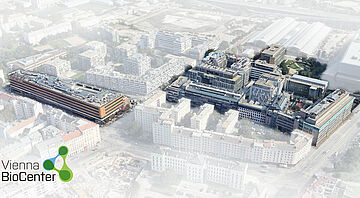
Gene Regulation, RNA, Epigenetics
How is genetic information stored and used?
Research in gene regulation and gene expression, RNA biology, and epigenetics at the Vienna BioCenter combines diverse approaches ranging from biochemistry and cell biology to genomics and transcriptomics to unravel the connections between genomes and the transcripts they encode. A particular focus is on RNA research, where myriad roles for this nucleic acid have only recently come to light.

Gene expression is at the heart of nearly all cellular processes. Differential gene expression is a prerequisite of multi-cellularity and the main driver of development, while failures in gene regulation cause many diseases including neurological disorders and diabetes. Sophisticated mechanisms exercise tight control over when, where, to what extent, and in what form genes are expressed. This makes the relationship between genotype and phenotype a complex one.

These control mechanisms are being unraveled at the Vienna BioCenter by studying regulation at different levels of gene expression: at the transcriptional level (e.g., transcription factors, regulatory DNA elements, DNA/chromatin modifications, and higher-order chromatin structure), the co-transcriptional level (certain non-coding RNAs), and the post-transcriptional level (e.g., splicing, RNA modifications, and RNA decay). Epigenetic processes alter phenotypes without changing the DNA sequence, and epigenetics research has long been a stronghold at the Vienna BioCenter, with seminal discoveries on DNA and histone methylation, and more recently on small RNA-mediated silencing.

Another strength lies in RNA biology research, with 17 RNA research groups working on messenger RNAs, transfer RNAs, ribosomal RNAs, and non-coding RNAs. The intimate involvement of RNA in gene regulation has become increasingly apparent in recent years. In particular, small RNAs, which include microRNAs, small interfering RNAs, piwi-interacting RNAs, and bacterial small regulatory RNAs, have fueled a renaissance in this field, with the Vienna BioCenter internationally recognized for its contributions.
Studies of small RNA-based defense systems in bacteria and eukaryotes not only provided fundamental insights into the ancient arms race between parasitic genetic elements and their hosts, but also led to powerful tools to silence gene expression or to edit genomes. These tools, including RNA interference- and CRISPR/Cas-based approaches, have revolutionized molecular biology.
The Vienna BioCenter organizes the annual Microsymposium on Small RNAs, which was founded in 2005 and has established itself as the major small RNA symposium in Europe
Research Groups "Gene Regulation, RNA, Epigenetics"
| Research Group | Institute | Topic |
|---|---|---|
| Berger | GMI | Chromatin Architecture and Function |
| Mari-Ordonez | GMI | Mechanisms of recognition and silencing of transposons in plants |
| Nordborg | GMI | Population Genetics |
| Swarts | GMI | Tree-ring genomics |
| Brennecke | IMBA | Transposon silencing & heterochromatin formation by small RNAs |
| Burga | IMBA | Molecular determinants of biological idiosyncrasy |
| Elling | IMBA | Functional genomics in embryonic stem cells |
| Jachowicz | IMBA | 'Dark' genome in early mammalian development |
| Mendjan | IMBA | Molecular control of human organogenesis |
| Rivron | IMBA | Blastoid development and implantation |
| Urban | IMBA | Regulation of neural stem cell quiescence |
| Busslinger | IMP | Stem cell commitment in haematopoiesis |
| Clausen | IMP | Molecular mechanisms of protein quality control |
| Gaidt | IMP | Functional genomics of the innate immune system |
| Pauli | IMP | Functions of short translated open reading frames (ORFs) in the context of development |
| Pavri | IMP | Molecular mechanisms of antibody diversification |
| Plaschka | IMP | mRNA processing and regulation |
| Stark | IMP | Understanding transcriptional regulation |
| Van der Veeken | IMP | T cell differentiation and function |
| Zuber | IMP | Finding and Understanding Cancer Dependencies |
| Ameres | Max Perutz Labs | Mechanism and biology of RNA silencing |
| Buecker | Max Perutz Labs | Transcriptional Regulation during Early Embryonic Development |
| Decker | Max Perutz Labs | Host responses and innate immunity to bacteria |
| Ellis | Max Perutz Labs | Cell Competition and Tissue Fitness in Development and Disease |
| Falk | Max Perutz Labs | Biogenesis and Action of small RNAs |
| Goerke | Max Perutz Labs | Signal Transduction and post-transcriptional regulation in model bacteria |
| Karagoez | Max Perutz Labs | Protein quality control in the endoplasmic reticulum |
| Koehler | Max Perutz Labs | Nuclear Pores - Regulators of Chromatin and Membrane Dynamics |
| Kovarik | Max Perutz Labs | Signaling and gene expression in inflammation |
| Kuchler | Max Perutz Labs | Host-Pathogen Interactions & Mechanisms of Drug Resistance & Fungal Pathogenesis |
| Leeb | Max Perutz Labs | Molecular control of cell fate decisions |
| Martinez | Max Perutz Labs | Biochemistry, physiology and disease of the tRNA splicing pathway in mammalian cells |
| Moll | Max Perutz Labs | Ribosome Heterogeneity in Bacteria |
| Querques | Max Perutz Labs | Genome Plasticity and Engineering |
| Slade | Max Perutz Labs | DNA damage response |
| Swarts | Max Perutz Labs | Tree-ring genomics |
| Tessmar | Max Perutz Labs | Lunar periodicity and inner brain photoreceptors |
| Weitzer | Max Perutz Labs | Somatic Stem Cells of the Heart |
| Zagrovic | Max Perutz Labs | Molecular Biophysics |
| Revilla-i-Domingo | Uni Vienna - Faculty of Life Sciences | Early Animal Evolution, Stem Cell Differentiation & Deep-Sea Sponge Ecology |
| Simakov | Uni Vienna - Faculty of Life Sciences | Evolution of Metazoan Genome Architecture |



